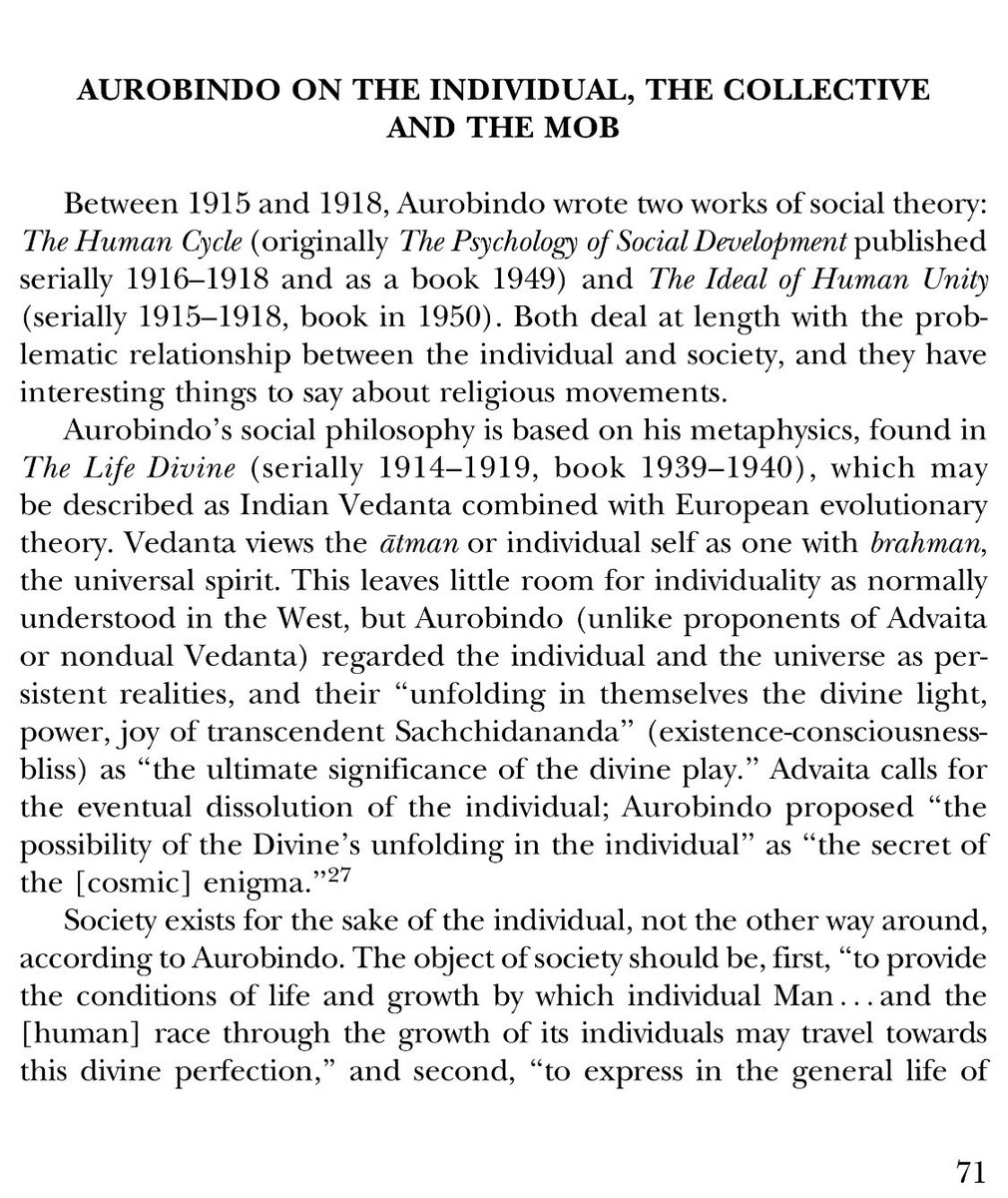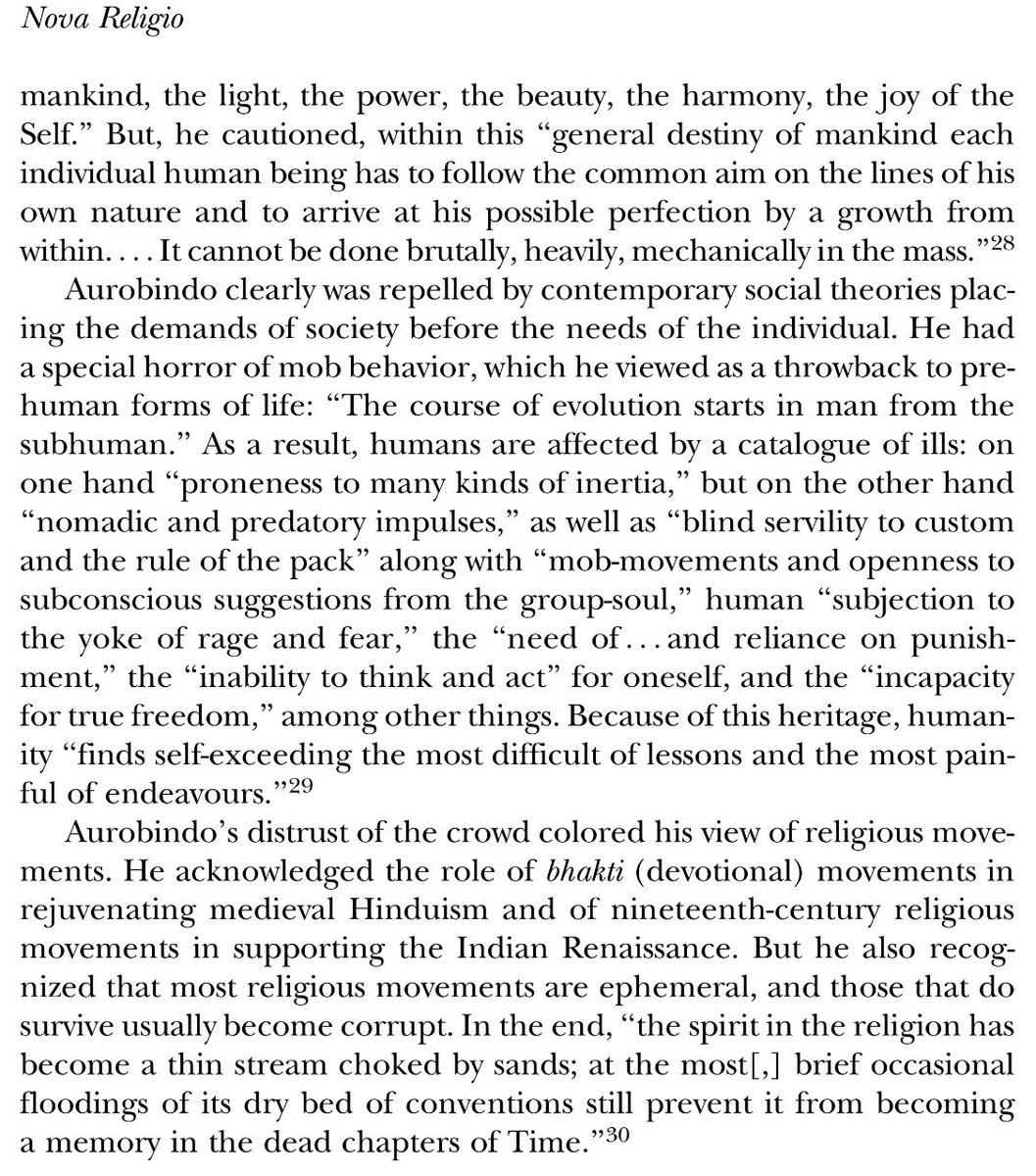Times of India-NEW DELHI: BJD member Bhartruhari Mahtab on Friday countered TMC MP Sugata Bose's reference to Aurobindo's formulation of nationalism ...
We, the Barbarians: my column today http://m.firstpost.com/politics/we-the-barbarians-a-spiritual-examination-of-the-hatred-anger-and-violence-that-has-captured-us-2644796.html … via @firstpost
@gchikermane Sri Aurobindo had much more to say about individual, group and, alas, mob. Extracts from a recent piece


Strong ideas @peterheehs "Society exists for the individual, not the other way around" "Subjection to the yoke of rage and fear"
Must read.
@gchikermane @peterheehs @UshyMohanDas [Luhmann: society consists not of actual people ... but rather communication] https://systemstheorysite.wordpress.com/2016/02/26/a-theory-of-society/ …
The most controversial claim made by Luhmann is that society consists not of “actual people and relations between people,” but rather communication–and only communication. Society is a communication system, and there are a number of distinct subsystems that have evolved; yet they are all “communication systems” (Luhmann, Introduction 28).
The first objection is always that there cannot be a human society without human beings. Of course, but they are only necessary preconditions; they are not society itself. In other words, society is not the aggregate of human beings. As Luhmann puts it, “Society does not weigh exactly as much as all human beings taken together, nor does its weight change with every birth and death” (Theory of Society vol 1, 7). Yet people do matter to human social systems because human social systems are simultaneously dependent on and independentof human beings. In other words, social systems are simultaneously dependent and independent of psychic systems, while psychic systems are simultaneous depend on and independent of organic systems.
Far from devaluing particular human beings, people gain a degree of freedom by not being participants in the social system. Where communication systems are concerned, people are free to come and go as they wish–and they do so by checking in and out of the communications of that social system, as when one member of a family completely severs communication with the rest of the family. Yes, people are needed to keep communication going, but individual people are easily replaced. If one person walks away, or even dies, there will always be someone new to take up the communication where the last person left off.
However, to head off another possible possible misconception, systems theory is not reductionist. Reductionism rests on the old whole/part distinction. For systems theorists, society is not a whole that consists or human beings or social institutions or anything else as parts. Society is a communications system, and it presupposes consciousness; however, communication cannot be reduced to consciousness. This entry was posted in Uncategorized. Bookmark the permalink. The site is maintained by Carlton Clark, Lecturer at the University of Wisconsin-La Crosse.
New Republic-15-Feb-2016 BY MARIA KONNIKOVA February 16, 2016
The term itself was coined about a decade ago by Gordon Shepherd, a neurobiologist at Yale, who has been studying the science of olfaction for more than half a century. His research has shown that flavor, a complicated and little-understood concept, does not originate in what we eat, but in what our minds derive from the experience. “Our sensory and motor appreciation of what we have in our mouth is created by the brain,” he said. “We can’t have gastronomy without it.”
But that, in fact, is taste, and though we tend to conflate it with flavor, a vast chasm exists between the two. Taste is an experience composed of ...This is the overarching principle that guides neurogastronomy: What we eat and why we eat it is as much a psychological phenomenon as a physical one. Throughout most of history, eating has been understood as a primitive human characteristic, an evolutionary necessity, the stuff of base survival instinct. This perception turns out to be far too simplistic. The more we learn about flavor, the more we realize just how easy it is to manipulate. Not just by the overclocked sensations of processed food, but in ways that makes healthier choices seem at once tastier and more satisfying. Though most of us would like to think we have discerning palates, our taste is quite easy to fool.
When we try to imagine the flavor of something, we tend to focus on our mouth—the experience of placing, say, a ripe strawberry on our tongue. But that, in fact, is taste, and though we tend to conflate it with flavor, a vast chasm exists between the two. Taste is an experience composed of only five elements: sweet, salty, bitter, sour, and umami. Thousands of receptors on our tongue are designed to identify and respond to these elements, each one specializing in one of the five qualities. Without input from other senses—most notably our nose, but also our eyes, ears, and even hands—taste is merely a flat, single-note sensation with none of the nuance or enjoyment we associate with food in general and with specific foods in particular. Flavor is at once a broader and more powerful property than taste, one that marries the senses and their associate properties—memory, experience, neurobiology—to create and control the way we eat.
The promise that neurogastronomy holds is that once we understand how the mind combines the disparate biological and evocative forces that create flavor, we will be able to circumvent the learned and innate preferences of our taste buds. And with that capacity—truly an example of mind over matter—instead of stimulating appetite via the conventional and unhealthy trifecta of salt, sugar, and fat, we can employ the neural pathways through which flavor is constructed in the brain to divert attention to different, more nutritious foods. Control flavor and you control what we eat—and perhaps, given time and more research, begin fighting the global nutrition problems that are a direct result of the industrialized production of food.
Barca Blaugranes (blog)
The discourse surrounding the literature provides a beautiful context in which productive disagreement is able to take place. The first book with which I’d like to start is one that’s fairly common. Jonathan Wilson’s "Inverting the Pyramid" walks readers through the progression of tactics within the world of football and describes the societal surroundings in which they took place. Tactics within soccer didn’t just develop through battles on the pitch (though that is largely a driving force). They developed in ways that allowed individual cultures to keep their identities while remaining competitive.
The book starts in England in the 19th century, and quickly progresses through the stylistic disagreements between the Scottish and English over the importance of individual talent and possession. From there, it follows a simple path to Central Europe... He describes why tactics blossomed in central Europe in the 1920s and 1930s, why Italy plays a very physical and defensive style, and how Total Football completely reshaped FC Barcelona.
Overall, I really enjoyed the book. It moves along very quickly, but it also does a fantastic job of developing a deep understanding of the game. It combines the intellectual side of the sport with the entertainment side, and helps give the reader a better insight into why some teams are better than others – even when the talent isn’t equal. The book isn’t perfect, by any means, and there are certainly pieces of literature that delve deeper into the tactical side of the sport, but this book is an incredibly valuable piece – regardless of where you are in your knowledge of the tactical game. Given the information, the entertainment, and overall quality of the writing itself, I have to give the book four stars out of five.



No comments:
Post a Comment